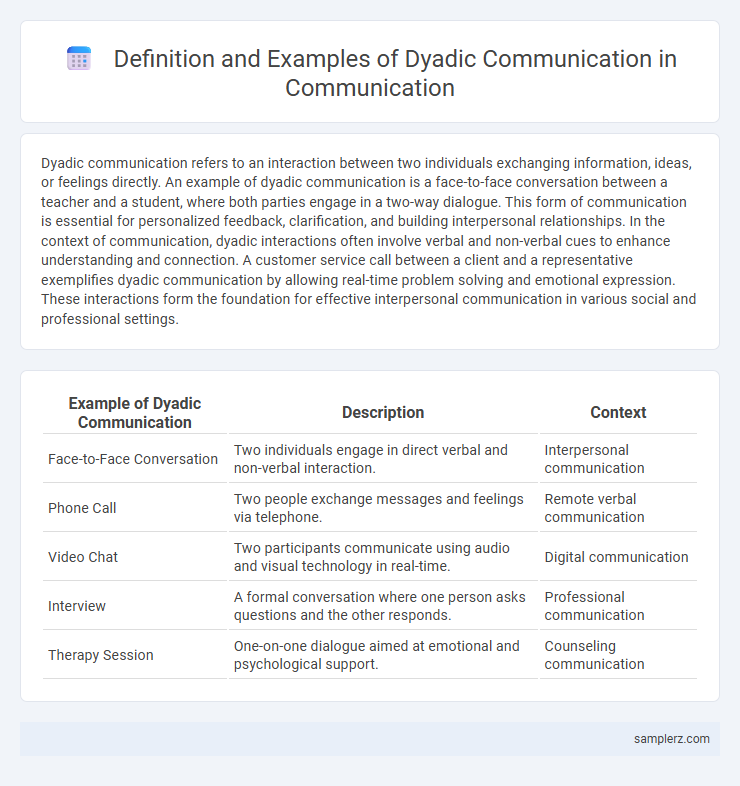Dyadic communication refers to an interaction between two individuals exchanging information, ideas, or feelings directly. An example of dyadic communication is a face-to-face conversation between a teacher and a student, where both parties engage in a two-way dialogue. This form of communication is essential for personalized feedback, clarification, and building interpersonal relationships. In the context of communication, dyadic interactions often involve verbal and non-verbal cues to enhance understanding and connection. A customer service call between a client and a representative exemplifies dyadic communication by allowing real-time problem solving and emotional expression. These interactions form the foundation for effective interpersonal communication in various social and professional settings.
Table of Comparison
| Example of Dyadic Communication | Description | Context |
|---|---|---|
| Face-to-Face Conversation | Two individuals engage in direct verbal and non-verbal interaction. | Interpersonal communication |
| Phone Call | Two people exchange messages and feelings via telephone. | Remote verbal communication |
| Video Chat | Two participants communicate using audio and visual technology in real-time. | Digital communication |
| Interview | A formal conversation where one person asks questions and the other responds. | Professional communication |
| Therapy Session | One-on-one dialogue aimed at emotional and psychological support. | Counseling communication |
Understanding Dyadic Communication: Definition and Importance
Dyadic communication involves direct, two-person interactions that are crucial for building trust and clarity between individuals. This form of communication enables immediate feedback, fostering mutual understanding and minimizing misinterpretations. Effective dyadic communication is foundational in personal relationships, counseling, and negotiation contexts, enhancing connection and collaboration.
Key Features of Dyadic Communication
Dyadic communication involves a direct interaction between two individuals, characterized by the exchange of messages in real-time with immediate feedback. Key features include its face-to-face nature, personal focus, and the ability for both participants to actively listen and respond, promoting mutual understanding. This communication type often relies on verbal and non-verbal cues, enhancing clarity and emotional connection between the communicators.
Everyday Examples of Dyadic Communication
Face-to-face conversations between two friends sharing personal experiences exemplify dyadic communication, highlighting direct verbal and nonverbal exchanges. Phone calls and video chats serve as everyday platforms enabling dyadic interactions, facilitating immediate feedback and emotional connection. Collaborative work meetings involving two colleagues discussing project details also illustrate practical examples of dyadic communication in professional settings.
Workplace Dyadic Communication Scenarios
Workplace dyadic communication occurs frequently during one-on-one meetings between employees and supervisors, where clear feedback and goal-setting are exchanged. Performance appraisals serve as a prime example, enabling direct dialogue to clarify expectations and address professional development. This form of communication improves collaboration, problem-solving, and trust within organizational teams.
Dyadic Communication in Personal Relationships
Dyadic communication in personal relationships involves direct, face-to-face interactions between two individuals, such as conversations between close friends or romantic partners. This form of communication emphasizes active listening, emotional exchange, and mutual understanding, which are essential for building trust and intimacy. Nonverbal cues, such as body language and facial expressions, play a significant role in enhancing the clarity and depth of dyadic communication within personal relationships.
Challenges in Dyadic Communication
Challenges in dyadic communication often stem from misunderstandings caused by differing personal communication styles and cultural backgrounds. Emotional barriers like anxiety or mistrust can hinder open and honest exchanges between two individuals. Effective active listening and nonverbal cues are essential to overcoming these obstacles and ensuring clear, meaningful interaction in dyadic settings.
Nonverbal Cues in Dyadic Interactions
Nonverbal cues in dyadic interactions include gestures, facial expressions, and eye contact, which significantly influence the clarity and emotional tone of communication. These nonverbal signals often convey underlying feelings, such as empathy or disagreement, without spoken words. Understanding and accurately interpreting these cues enhances mutual comprehension and strengthens interpersonal connections in one-on-one conversations.
Effective Strategies for Dyadic Communication
Effective strategies for dyadic communication include active listening, where participants fully concentrate, understand, and respond thoughtfully to each other. Using open-ended questions encourages deeper dialogue and clarifies mutual understanding. Maintaining nonverbal cues like eye contact and nodding enhances connection and reinforces the message exchange.
Dyadic Communication in Counseling and Therapy
Dyadic communication in counseling and therapy involves a direct, two-person interaction between the therapist and the client, fostering an intimate and confidential environment essential for effective psychological support. This one-on-one dialogue enables personalized feedback, active listening, and tailored interventions that promote emotional healing and behavioral change. Research shows that dyadic communication significantly enhances therapeutic outcomes by building trust and facilitating deeper self-exploration.
Enhancing Dyadic Communication Skills
Enhancing dyadic communication skills involves active listening, clear verbal expression, and nonverbal cue awareness between two participants. Techniques such as paraphrasing and providing constructive feedback optimize understanding and reduce misinterpretation in one-on-one settings. Practicing empathy and maintaining emotional regulation further strengthen trust and collaboration in dyadic interactions.

example of dyadic in communication Infographic
 samplerz.com
samplerz.com